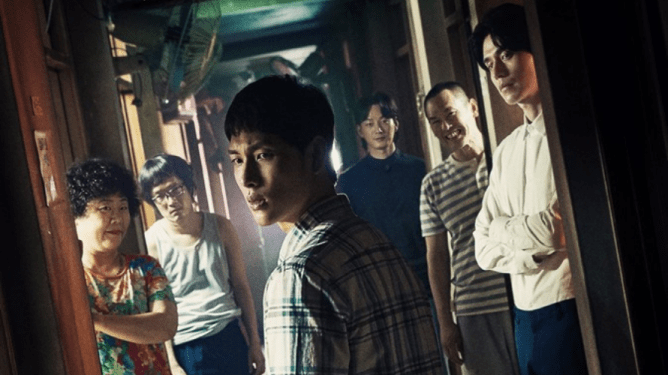Hell Is Other People Review
June 2, 2020
Hell Is Other People is a South Korean thriller/horror series on Netflix that aired last summer. Being a rom-com kind of girl, I’ve never been particularly interested in scary things. (Watching The Conjuring at a sleepover was traumatic enough.) But let me tell you, this is the kind of show that you start with absolutely no expectations, but it ends up taking over your mind.
The show tells the story of a young man from the countryside, Yoon Jong-Woo, who moves to Seoul because of a new job offer. He’s poor and settles into a rather impoverished side of the city, where he moves into a dormitory. The type of dormitory is fairly common, where each resident gets a tiny room (and when I mean tiny, I mean really tiny) and all residents have to share the same kitchen and bathroom. He finds the cheapest one of all, so this one is especially derelict and filthy. Jong-woo is a sensitive guy, so he hates living in the dormitory and he dislikes the other residents, who seem very strange and suspicious.
One word to describe this show would be “unpleasant.” It makes you feel very uncomfortable from start to finish, and even when the show ends, it makes you think about it nonstop. There are scary elements like killing and murder, but I believe the main reason why it’s so uncomfortable to watch is that it reveals so much about today’s world and society. Topics such as money and societal tensions come into play, making the show disturbingly relatable to the general public—not just in South Korea, but in countless parts of the world.
A factor that makes this drama so memorable is the screenplay. While regular Korean shows air around sixteen to twenty episodes, this one only airs about ten. It’s filmed in a particular way that makes it seem as though you’re watching a very, very long movie. There’s also a sort of filter over the show so that everything seems a bit washed out and dark.
Another memorable part of the show is the acting. I’ve been quite familiar with the leads due to the exposure of my Korean heritage from a young age, and I didn’t think I could get quite familiar with the “dark side” of the actors after watching them trip over their own feet on variety shows. However, they really did succeed in making me scared of them. The portrayal of fear, fury, and insanity on their faces seems truly authentic; it amazes me how they can mold their faces into any expression.
The male lead is a seemingly normal guy despite his sensitivity. He does have a tendency to get angry and not be able to hide his emotions. He looks down at the other residents, thinking that he is better than them. He does not want to be associated with them nor let other people at his company know that he lives in a dormitory. After moving to a big city like Seoul, he feels like nobody is on his side. Even his girlfriend, who is dealing with her own societal issues, is tired of him telling her how strange the other residents are.
I honestly can’t blame him, though. The other residents are a little beyond suspicious. First, there’s the landlady, whose husband mysteriously died and who always seems to be marinating a strange kind of raw meat, as well as always giving the male lead weird drinks that make him hallucinate. Next is the pervert (he has a band around his ankle that shows that he’s a rapist) who keeps staring at the male lead with a knife behind his back. There is also a set of twins—one seems to be normal and the other seems to have a developmental disability. He laughs hysterically and stutters, but he seems to know more than he lets on. Finally, there’s the boss of all residents: a handsome, charming dentist. The catch is that he thinks killing is an art form and he likes extracting teeth while torturing his victims (he makes a pretty charm bracelet with them). He also sees potential in Jong-woo to become a serial killer like himself and he starts a plan to make his potential come true.
The story explores a fascinating concept as well: are killers born or nurtured? Although Jong-woo is very sensitive and has had some anger-management issues, he has been able to live a normal life. As the story progresses, though, the viewers can see him becoming more and more like the residents that he looked down upon: he glares (really creepily) at strangers, buys a knife and starts carrying it around his back while talking with people normally, and more. Was Jong-woo built like that from the beginning, or was his slow downfall a result of the psychopath dentist’s elaborate plan? How did the dentist even come to love “the art of killing”?
The phrase Hell Is Other People was familiar to my ear, so I searched it up. It’s actually a quote in Jean-Paul Sartre’s play No Exit. The story follows three people who die and enter hell, and hell looks like a simple drawing-room. They try to figure out what their sin was and what kind of torture is waiting for them, but they quickly figure out that there is no hellfire, devil, or torturer. It’s just the three of them in that room. Eventually, each of them realizes that the other characters in the room are the punishment.
After I finished the show, I lay down on my bed and stared at the ceiling for about an hour. I found out that the show is derived from a webtoon, or a web-comic, of the same name, so I searched it up. The art style is honestly terrifying and it will give me a nightmare for days. Although Hell Is Other People is a rather depressing show to watch, it carries a strong message about today’s people and society. Ultimately, it makes you think that if there is a place with those kinds of people somewhere on this Earth, it would truly be the epitome of hell.

















































































































































